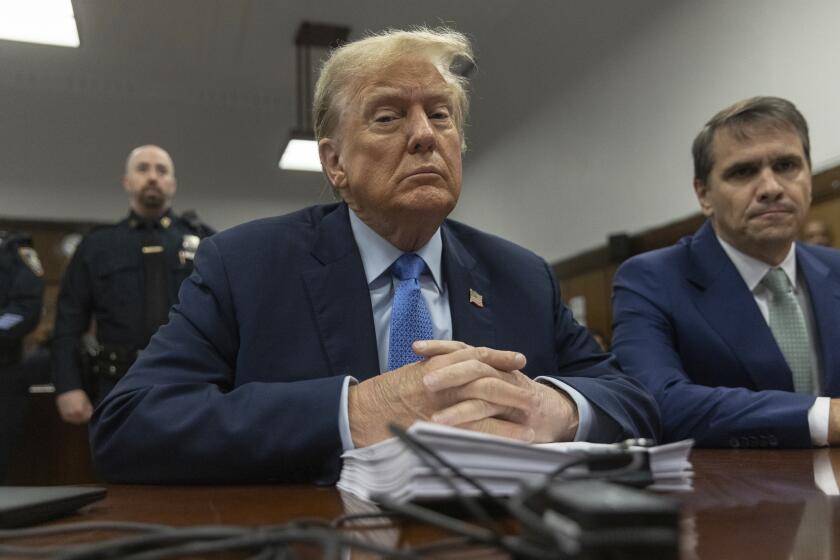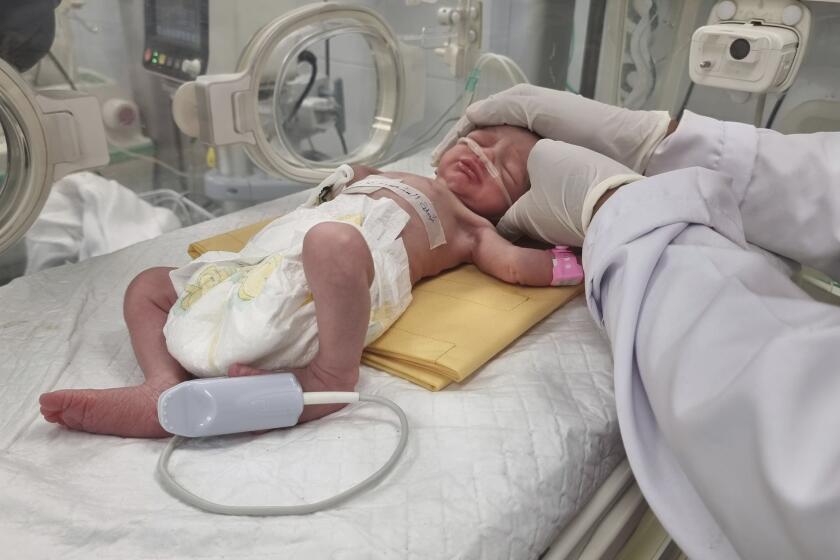Iran’s supreme leader demands support of clerics
Iran’s supreme leader wrapped up an unprecedented 10-day visit to the Iranian seminary city of Qom on Friday that was widely seen as an attempt to bolster support among those in a clerical establishment either indifferent or hostile to his conservative agenda.
FOR THE RECORD:
Iran clergy: An article in the Oct. 30 Section A about Iranian supreme leader Ayatollah Ali Khamenei and reform-minded clergy said an influential cleric, Ayatollah Hossein-Ali Montazeri, died 40 years ago. He died last year. —
In a series of meetings, Ayatollah Ali Khamenei warned turbaned leaders of the Shiite Muslim clergy to avoid becoming excessively enamored of unorthodox, reformist and Western ideas and too unsupportive of the hard-line government of President Mahmoud Ahmadinejad, who has long aroused suspicion among Iran’s clerical old guard.
“The enemy had decided to make the antithesis of the revolution here and to turn Qom into a base for counter-revolutionaries,” Khamenei told supporters in the city Wednesday, amid saturation media coverage. “They tried to influence the thoughts and emotions of the people of Qom. They assumed they could quell the flame of people’s emotions or damp their feelings.”
Khamenei, Iran’s highest spiritual and political authority and its commander in chief, has long had a frosty relationship with senior clergy in Qom, an important city whose educational establishment has conducted a decades-long flirtation with Western and liberal ideas.
A former president, Khamenei was elevated to his powerful post in 1989 despite lacking the theological qualifications or religious stature of his predecessor, Ayatollah Ruhollah Khomeini, founder of the Islamic Republic. Now, in a complicated maneuver that resembles the high ecclesiastical and political intrigue of the medieval papacy, Khamenei is seeking to shore up his own standing by bending skeptical clergymen to submit to his will.
“He’s in Qom to say if you want an Islamic Republic, you have to support me,” said one analyst in Tehran, who like others interviewed, spoke on condition of anonymity because of the sensitivity of the topic.
Since Khamenei’s ascent, an influential — but officially constrained — reform-minded clerical faction close to the teachings of the late Ayatollah Hossein-Ali Montazeri has emerged, espousing new ideas about Islam’s relationship to democracy and human rights.
Among the movement’s political standard-bearers have been former Prime Minister Mir-Hossein Mousavi and former parliamentary Speaker Mehdi Karroubi, a mid-ranking cleric, who both lost to Ahmadinejad in last year’s disputed presidential elections.
Hard-liners close to the Revolutionary Guard, who consolidated their grip on power in the violent crackdown after the election, have all but excised reformists from the circle of power. In one of his many speeches in Qom, Khamenei controversially referred to postelection protests as a “vaccination” that rid Iran of political and social “microbes,” a characterization that many supporters of the opposition found insulting.
Reformist ideas continue to persist in Qom, where dissidents such as Ayatollah Yousef Saanei — who had been an ally of Montazeri, who died 40 years ago — continue to be among the most respected clerics among students even as Ahmadinejad supporters regularly attack them.
In addition, a large group of “quietist” clerics, who generally deride involvement in nitty-gritty politics as being anti-Islam, have steadfastly refused to endorse Ahmadinejad or adopt Khamenei’s rhetoric about the election protests. The supreme leader describes them as Western-backed “sedition” aimed at overthrowing the Islamic Republic, established in 1979.
The nonpolitical clerics, along with a group of so-called traditional clerics that includes Ayatollah Ali Akbar Hashemi Rafsanjani, have given Ahmadinejad and his cohorts the cold shoulder in part because they object to a messianic, evangelical approach to Islam.
In his appearances, Khamenei insisted that if the traditionalists and quietists don’t support him, the whole system could collapse.
“Some may say that if theological schools did not become involved in political and challenging issues, then they would not have had so many enemies and would have been more respected than they are today,” he told clerics last week. “That is a wrong argument. Never has any group, foundation or valued gathering achieved public respect by isolating itself, separating itself from others and adopting neutral positions.”
He added, “If any damage is inflicted on the Islamic system, the clergy … will lose more than anyone else.”
So far Khamenei’s efforts have not appeared to resonate, analysts say. Although tens of thousands of supporters embraced Khamenei as he arrived in Qom and the clergy received him warmly, there are no signs that the visit has led to a change in political positions.
Moreover, the biggest battle in Qom isn’t between reformist and conservative clergy, but within the conservative bloc itself, among opponents and supporters of Ahmadinejad.
During his visit to Qom, Khamenei reminded the clergy of the increased government funding that has been lavished on Qom’s seminaries and institutions. “Khamenei, through Ahmadinejad, has pumped them up with so much money they can’t honestly claim to be independent,” said one political scientist.
But with those funds, the once-sleepy town, home to an important Shiite shrine, has grown into a cosmopolitan city of over 1 million, and its growth has exposed it to outside ideas and influences. Clergy and students from seminaries in the Iraqi cities of Najaf and Karbala, which at times have been far more important, often marvel at the advanced philosophical and scientific discussions in Qom.
But in keeping with Khamenei’s push against liberal thinking, the Iranian government recently announced that the college-level teaching of 12 humanities subjects, including law and philosophy, would be reevaluated and perhaps scrapped.
“Liberalism was created in accordance with the ideology of humanism, democracy and other similar things,” Khamenei told Qom students on Tuesday. “The goal of these ideas and ideologies and their promoters was to establish and create tranquility and welfare for human beings. However, in reality, the outcome of these ideas were in contrast with their initial goals .… The worst wars and killings took place and human beings behaved in the most horrible ways toward one another during this period.”
Most likely the 71-year-old cleric is also seeking to enhance his stature and cement his legacy. His most ardent supporters have begun referring to him as “Imam Khamenei,” conflating him with his predecessor, who is often described as “Imam Khomeini” and revered by supporters as a saintly or God-like figure. Supporters recently published Khamenei’s family tree, showing his descent from the family of the prophet Muhammad.
“Until now he lived in Khomeini’s shadow,” said one Tehran analyst. “The leader … has now declared himself a saint.”
More to Read
Start your day right
Sign up for Essential California for news, features and recommendations from the L.A. Times and beyond in your inbox six days a week.
You may occasionally receive promotional content from the Los Angeles Times.





